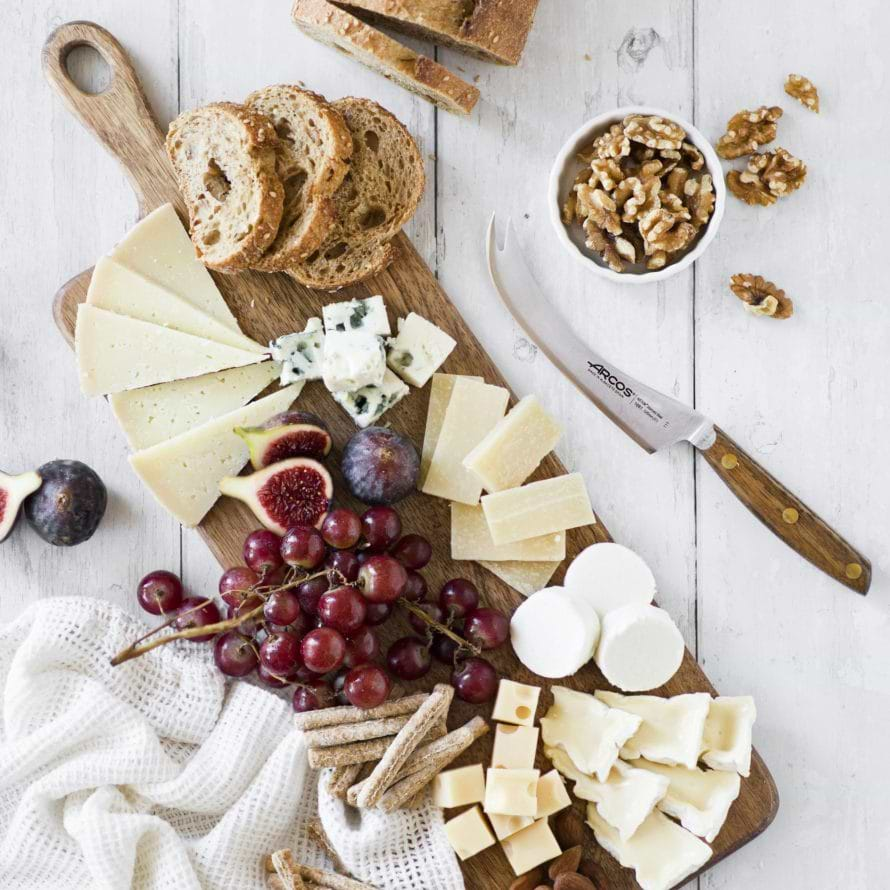How to choose the right knife for each type of cheese
Flavors, textures, and incredible aromas that further enhance your sense of smell. This is the world of cheese—a universe to be enjoyed with all five senses. And, just like fine wines and other foods from Spanish gastronomy, cheeses deserve to be savored with the most suitable tool: a cheese knife. But beware, we are not talking about just any knife; we mean specific cheese utensils designed to cut efficiently according to the type of cheese you want to taste.
If you are a cheese lover, no matter where your favorites come from, and you have ever wondered why there are so many different cheese knives, you have come to the right place. With the help of our specialists in knives and kitchen accessories, we will explain which are the most common cheese knives, what each one is used for, and how to use them properly. Let the tasting begin!
Cheese knife, what is it used for?
No matter the shape, appearance, or size, cheese knives are specifically designed to cut this delicious delicacy as efficiently as possible, without it falling apart or sticking to the blade.
From soft to aged cheeses, with rind, fresh, hard, or with mold—the type of knife you choose to cut any of them will directly influence their final presentation, flavor, and, of course, your own tasting experience.
You may have noticed that some types of cheese knives have peculiar shapes, such as two prongs, which serve a very specific function when cutting this food. The purpose of these prongs is to pick up and serve each piece of cheese once it has been cut, so you don’t have to touch it with your hands. It’s an extra touch of practicality and elegance when tasting cheese with friends. They’ll be amazed by your expertise!
Types of cheese knives
As we mentioned before—and as you probably already knew—there is a specific knife for each variety of cheese. It’s true that you don’t need to have the entire set of cheese knives in your kitchen, but you should know them well so you can choose the one that best fits the type of cheese you’re going to cut on your board.
- Soft cheese knife: Easily recognized by its perforated or hollowed blade, which prevents the cheese from sticking to it. It’s perfect for cutting Brie, Camembert, or goat cheese log.
- Hard cheese knife: This knife is much more robust, designed with a short blade and an almond-shaped tip. Ideal for cutting, chipping, or even shaving aged cheeses like Parmesan.
- Aged cheese knife: Its blade is much firmer and sharper than the others. With this type of knife, you can cut hard cheeses like Parmesan or Manchego without crumbling them.
- Universal cheese knife: Made with two prongs at the end, resembling horns, and stands out for its excellent versatility. It allows you to cut semi-soft cheeses and even serve them without touching the piece.
- Wire or lyre cheese cutter: One of our favorites for making very clean cuts on the softest or blue cheeses, such as Gorgonzola or Roquefort.
- Spatula or cheese spreader: More of a tool than a knife, it lets you easily spread creamy cheeses like ricotta or mascarpone.
- Cheese hatchet: Yes, you’re probably laughing at the peculiar name of this cheese knife. It’s the most recommended for the firmest cheese blocks, as it has a thick, short blade that lets you apply force without damaging the texture.
The best thing about having the right knife for each type of cheese is that it greatly enhances your tasting and sampling experience, especially because the cheese won’t suffer any damage.
In addition to these knives, there are other cheese utensils you might need if you’re a true cheese lover. From a cheese grater to serving tongs or forks, a cheese dome for storage, or special cutting boards.

How to use cheese knives
The best thing to do is to use the specific knife for each type of cheese. Make sure they are always well sharpened and, of course, clean. Make your cuts as precise as possible and, whenever you can, serve the cheese at room temperature. If you cut it this way, I assure you that you will enjoy it much more.
Now, after all this, there’s only one thing left: enjoy a delicious cheese pairing. See you in the next article.


